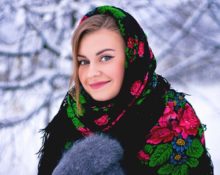 Maybe scarves once went out of fashion, but that was only because they weren't so diverse. Abundance of colors and variety of shapes. And they all deserve praise. Close attention to the scarf with knitting needles. How to tie it? What yarn and knitting needles are useful for this? And which of the schemes is suitable, maybe something should be left to blouses and vests?
Maybe scarves once went out of fashion, but that was only because they weren't so diverse. Abundance of colors and variety of shapes. And they all deserve praise. Close attention to the scarf with knitting needles. How to tie it? What yarn and knitting needles are useful for this? And which of the schemes is suitable, maybe something should be left to blouses and vests?
Preparing to knit a scarf
For knitting, you must correctly determine the type of yarn. Fibers that are too heavy can simply turn elegant models into incomprehensible rags.
Basic symbols on the diagrams
Knitting has its own patterns, but there are so many of them. Very often one element can be displayed with different signs. For example, the front loop can be a dark square or just a stripe. Therefore, pay attention to the specific model and instructions - there should always be an explanation for each icon. Here is one example of circuit designation.
Selecting threads
 The scarf can be knitted with different threads. Therefore, the best choice is the choice of a needlewoman.You can distribute depending on the warmth (more wool - warmer). Color preferences and fiber structure may vary.
The scarf can be knitted with different threads. Therefore, the best choice is the choice of a needlewoman.You can distribute depending on the warmth (more wool - warmer). Color preferences and fiber structure may vary.
Knitting patterns for scarves
 Initially, perhaps, there were several schemes. For example, Orenburg downy shawl - it is the first association when mentioning the product. The corresponding scheme was assigned to him. It has been created for decades without a single deviation. The scheme suited him so well, so to speak. Today there are no special rules for making a scarf. If you want elastic, you want volume. No one deprived the right to choose a lace other than that of the Orenburg model. Various meshes, honeycombs and other patterns. All this well-being is diluted by an interesting border, which makes the product complete. Beginners can create a simple fabric and simply tie it with a lace border - and it will be perfect.
Initially, perhaps, there were several schemes. For example, Orenburg downy shawl - it is the first association when mentioning the product. The corresponding scheme was assigned to him. It has been created for decades without a single deviation. The scheme suited him so well, so to speak. Today there are no special rules for making a scarf. If you want elastic, you want volume. No one deprived the right to choose a lace other than that of the Orenburg model. Various meshes, honeycombs and other patterns. All this well-being is diluted by an interesting border, which makes the product complete. Beginners can create a simple fabric and simply tie it with a lace border - and it will be perfect.
We knit a scarf with our own hands: patterns and description
It is not difficult to make such products with your own hands, if the pattern allows it. There are also quite complex schemes; they are not recommended for beginners. It is necessary to go through the ladder from the first step and gradually approach more complex models. But knitting skill is a huge plus. The more you knit, the faster you get results. After all, the speed becomes faster and at the same time the loops are smoother.
Important! Doctors have noted the fact that seriously ill patients experience relief, and some even get better, deciphering the complex patterns of the canvas. The thing is that a person constantly counts loops and rows. This way he pushes aside sad thoughts, and this is very important at the time of illness.
 Scarves can be of different shapes. Some are even close to scarves and fashionistas use them like this: they simply tie them around their necks. From the outside no one will think that this is a scarf.Regular square models, triangular ones, variations that are closer to bactus. New items are models in the shape of a semicircle. With small lace collars. How many categories open up, you just have to dig deeper. But the coolest and most elegant models are collected in this review with diagrams and descriptions. Let's try ourselves as a clothing designer and knit a scarf for ourselves and our loved ones.
Scarves can be of different shapes. Some are even close to scarves and fashionistas use them like this: they simply tie them around their necks. From the outside no one will think that this is a scarf.Regular square models, triangular ones, variations that are closer to bactus. New items are models in the shape of a semicircle. With small lace collars. How many categories open up, you just have to dig deeper. But the coolest and most elegant models are collected in this review with diagrams and descriptions. Let's try ourselves as a clothing designer and knit a scarf for ourselves and our loved ones.
Knitted thick scarf
 A tight pattern can be made with knitting needles by anyone who knows how to knit knit stitches, purl stitches and how to make yarn overs. After all, this is all you need to create an elegant scarf model.
A tight pattern can be made with knitting needles by anyone who knows how to knit knit stitches, purl stitches and how to make yarn overs. After all, this is all you need to create an elegant scarf model.
To work you will need:
- yarn Tosh DK 3 skeins (100% merino) 615 m;
- circular knitting needles 4.5 mm.

The gauge of this knitting is 16 stitches = 10 cm in stockinette stitch. The width of the model is 117 cm. You can make it wider or narrower if you wish. The model is knitted from the center of the base (triangle) and down. For the initial set you will need only 5 loops.
After knitting according to the pattern:
- 2 knits/pet, yarn over, 1 knit/pet, yarn over, 2 knit/pet.
- K/st until the end of the row (there will be only 7 loops and this is the wrong side of the fabric).
- Continue rows with yarn overs and between one knit stitch. As a result, due to two yarn overs in each front row, an increase of two loops will be obtained. This is how the scarf will gradually expand and increase in size. Continue knitting until the desired length (in this case, up to a length of 117 cm). The scarf will be dense due to the garter stitch pattern. It will look triangular due to two yarn overs that turn the work and expand it to the sides.
 Border of the product: it is created using 1*2 elastic band. On the front side there will be one front and two purl loops.Additions along the border make it with a slight wave.
Border of the product: it is created using 1*2 elastic band. On the front side there will be one front and two purl loops.Additions along the border make it with a slight wave.
On a note! The increases will be unnoticeable if you add loops between the front loops of the elastic band.
Knit 10 cm of elastic and bind off the loops. In the last row you will get an elastic band of 1*3 (this is achieved by gradual additions). Then you can close the loops according to the fabric pattern. An elegant and thick scarf is ready and can be worn with jackets, cardigans and coats.
Scheme of an openwork scarf with knitting needles
 Anyone who has not knitted will not understand that each pattern has its own ideal pattern. If the braids are better visible in gray tones of the yarn, then this pattern is definitely better in the rich blue color.
Anyone who has not knitted will not understand that each pattern has its own ideal pattern. If the braids are better visible in gray tones of the yarn, then this pattern is definitely better in the rich blue color.
To work you will need:
- Alize Real yarn (100 g contains 480 m);
- knitting needles number 2;
- hook 2 mm.
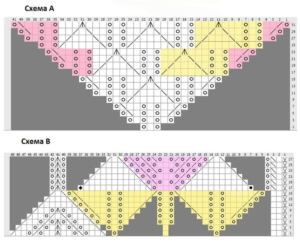

Job This is done not only with knitting needles, but a hook helps a little at the end, because it is this that creates the last air fibers. The openwork from pattern A is knitted with knitting needles, but only one half of the scarf is indicated. The second one is knitted symmetrically and immediately. Therefore, you need to cast on the knitting needles twice as many stitches as shown in the diagram. This pattern is knitted faster, despite the fact that there are more rows. The thing is that the rows will be shorter at first, then they will gradually expand due to the central loops and yarn overs. Next, we move on to pattern B and knit the larger elements of the openwork fabric. A hook will help you finish knitting. You need to follow this loop closure scheme:
- several loops together;
- 6 air loops.
The pattern of the canvas itself will tell you. But in the end you should end up with such a beautiful weaving.

You can finish the row with knitting needles, but it will be long and difficult.
Don’t be discouraged if you don’t like the canvas after finishing the work.Like all knitted items, the product needs to be wet and stretched. This way all the loops will dry and take the correct position. And you will get a product like in the photo. Such beauty, it’s a pity to even crush it.
Knitted Scandinavian scarf
The model of the Scandinavian scarf is distinguished by its shape - it is almost a triangle. It is obtained by yarn overs or decreases with bends.
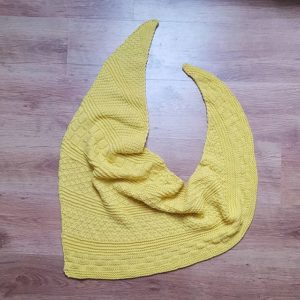
To work you will need:
- 200–300 grams of yarn with the addition of acrylic;
- knitting needles of the appropriate size, depending on the thickness of the yarn.

The model uses a checkerboard pattern, stockinette stitch and purl stitch. These are completely different elements, but together they create something unusual. Therefore, with them it may well turn out to be a Scandinavian scarf.

A very bright color was chosen for the canvas, and so the patterns began to play in a new role. The pattern shows that you can knit in different directions. The result will be one canvas.
Use knitting needles to cast on the desired number of stitches. Next, make decreases in one row, two at a time. Do this every second person (or every fourth in the general sense). But at the same time make increases on the opposite side, in the same way.
Knitted down scarf
A very interesting model of a down scarf. Beginners will probably think, why complicate everything - it’s just a square canvas. In fact, a scarf is not that easy to knit. Especially this model. After all, knitting occurs in corners and in different directions. It's easy to get confused, but that's not what this description is for. So, let's try and figure it out together.

To work you will need:
- goat fluff 90 g;
- contrast thread;
- knitting needles No. 2;
- pins or stitch holders.

The diagram produces several corners that will need to be connected together using central loops.
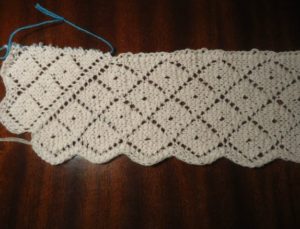
Using this analogy, you need to create another angle. To do this, you will need to knit one of the sides of the border to the desired length.
Next, attach the second diagram of the model to the work.

This pattern will run through the center of the scarf, between the three sides of the border. For it, you will initially need to cast on loops from one of the inner sides of the border. Work in the opposite direction from the border and join the right and left sides on each row, simply knitting the stitches together. Once the required length is formed, move to the border, which will be the fourth side of this scarf. Attention - the diagram should form a square in the center. All loops must be counted and knitted with the same density. The last border is knitted very similarly to the middle of the scarf, only the loops are caught on one side (from pattern number two).
Knitted bactus scarf
It can be called today “the most fashionable scarf.”

To work you will need:
- medium thickness yarn;
- knitting needles No. 3.
For bactus you need only two schemes:
- facial surface;
- purl stitch.
Three steps in work:
- Starting work from a corner. Cast on three stitches with knitting needles. Knit 6 rows in stockinette stitch. In the last row in the last loops, add one loop. Change the pattern to purl stitch. And again 6 rows and again adding 1 loop. By analogy, create 40 cm.
- Step for obtaining a rounded profile. In each even row, increase 1 stitch on the inner side. From the outside (this one is opposite the increases from the first stage), make decreases using the same technology. Do this exactly 30 cm.
- At the beginning of every 6th row, bind off 4 loops. At the same time, create increments along the loop: in an even row - at the end, in an odd row - at the beginning. Close when the desired length is reached.
Knitted head scarf: diagram and description
A very simple knitted scarf model. But you need to master the crochet technique. Since the border was created only with the help of it.
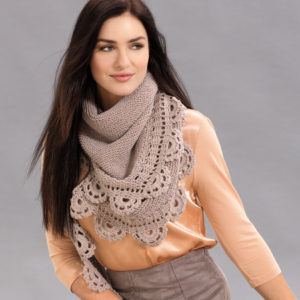
To work you need:
- yarn 200 g;
- knitting needles No. 3;
- hook number 3.
The work has the following sequence:
- Create a square fabric using garter stitch.
- Crochet around the perimeter.
Options for beautiful patterns for scarves
The most popular patterns for scarves are openwork patterns. Here is a small selection of cool patterns for creating a scarf.



How to knit a beautiful border for a scarf with knitting needles
You can easily and simply crochet a border; even simple air loops can create an attractive wave. But doing this with knitting needles is a little more difficult without knowing the pattern. A selection of patterns for the border of a scarf.


How to knit a scarf with knitting needles quickly and easily
Peering at the scarf models described above, a beginner can simply abandon the idea. To prevent this from happening, we offer the following model of a very simple and elegant scarf for the beginner.
Knitting patterns for a scarf for beginners
The simplest canvas model. This is a garter stitch and a triangle shaped scarf.

To work you need:
- children's pekhorka yarn 250 g;
- knitting needles No. 2.
Knitting starts from the corner. Cast on 3 stitches with knitting needles. Knit without changes. Next, in each row of the front, increase one loop from the edge. The other side is unchanged. When the product is equal to 1/2 of the required amount, begin decreasing, symmetrically to adding. On the same side. Now our product is ready.
There is a scarf model for everyone. Therefore, we gain patience, yarn, knitting needles and forward.


 0
0

